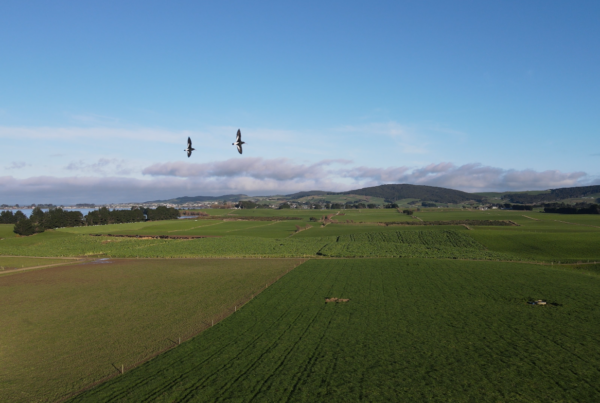Regenerative agriculture is a term that is slowly gaining a level of acceptance in the New Zealand agricultural sector. For many years the term and its principles have been scorned in some corners. We are now seeing an increasing uptake by farmers utilising many of its principles, an increase in media coverage and broader acceptance of the term and practices generally.
Nestle’s “Net Zero” sustainability initiative is tackling emissions in its own business and supply chain. This in turn has created a great opportunity for Fonterra to ensure that sustainably grown dairy product is sourced through their supply chain. This represents a premium return on milk solids for participating dairy farmers in New Zealand.
Corporate initiatives like these combined with the New Zealand government roll out of nitrogen cap legislation and the recommendations of the Climate Change Commission means there is a shift in mindset occurring within the sector.
The truth is that many New Zealand farmers are already undertaking some of the guiding principles of regenerative agriculture and reaping the benefits. As such, they have the ability to move further along the continuum towards environmentally friendly, economically sustainable farming through evolutionary rather than revolutionary means.
Here are six regenerative practices and benefits that you may well be doing right now.
1. Reduced soil disturbance
Minimising soil disturbance by methods such as zero-till, reduced tillage or direct drilling are becoming more common place in New Zealand land management practices. Be it through capital investment or contract drilling, farmers are looking to direct drilling technologies to hold in the moisture, minimise soil disturbance and incorporate more carbon and nitrogen fixing from the residual crop.
The transition to healthier soil does not happen overnight, but it does happen.
No-till farming leaves crop residues on the surface, which absorb water and limit runoff. This water retention can be critical to farmers in drought-stricken areas and can lead to improved crop yields due to the additional water retention.
2. Increase plant and microbial diversity
Crop rotation is defined as the intentional planting of different types of crops in different paddocks through each season in a sequential manner. It also requires seasonal periods of no planting to give the land time to recover.
Crop rotation helps increase soil fertility and improves crop yields.
Because each plant type uses different nutrients and promotes different micro-organisms through its growing cycle, this improves soil fertility by replenishing nutrients that are not available or utilising nutrients in abundance as you cycle through each season.
The improvement in the nutrient availability through crop rotation will, in time, lead to improved yield.
Soil structure will improve through crop rotation which helps prevent soil compaction, improves soil aeration, reduces soil erosion and delivers better water retention.
3. Keep the soil covered
Cover crops are a long-term investment in improving soil health, controlling erosion, improving water filtration and managing the natural production of nutrients. The benefits can begin to accrue in year one and build over a few years.
Because cover crops take up space and light, they shade the soil and reducing the opportunity for weeds to establish themselves.
Legume cover crops such as clovers, peas and beans can fix a lot of free nitrogen, from the air, for subsequent crops within the nodules on their roots. This can range from 60-180kg of N per hectare depending on season and species.
”To help build resilience in soil a diverse range of plant species is needed above the ground to cultivate a diverse microbial ecosystem below the ground.
4. Diversify to reduce risk
Diversity in crops brings stability with the ability for the plants to manage abiotic stressors such as flood, drought and temperature extremes better. The more diverse the soil-borne organisms that inhabit a farming system, the more diverse the populations of pest-fighting beneficial organisms a farm can support. For example, healthy soils enriched and revitalised by rotation and cover crops promote root development and water infiltration, thus are less prone to disease.
5. Stimulate organic matter
There are many practices that will stimulate and increase organic matter in the soil. Anything less than about 20% organic matter in the soil (as scientifically measured with a soil test) means you have room for improvement.
Adding compost, returning crop residues, adding micro organisms from EMNZ, crop rotation and diversification and the planting of nitrogen-fixing legumes all play a role in stimulating organic matter in your soil.
Of course, with organic matter you need to feed it and that is where the application of Fish IT Refined comes in to its own.
6. Sustainable grazing practices
There are many variables to sustainable grazing practices including such matters as stock count, grazing intensity and climate. The focus in this blog is around delivering resilience to your pastures to better handle the stresses of climate and deliver nutritious feed to your healthy livestock.
Pasture growth is determined by a combination of rainfall intensity and the ability to store your rainfall in the soil, ground cover, soil type and condition, evaporation, slope and tree cover.
In short, better quality soil leads to better quality pasture. Soil health has a direct impact on protein levels in pasture. Low soil phosphorous and nitrogen are the most common restrictions on pasture growth. By taking the approach of cover crops, crop rotation, multi-species diversity and nitrogen-fixing legumes you will maximise your pasture yield, quality and resilience to abiotic stresses whilst being able to manage downward some of your synthetic inputs and associated cost.
Farmers across New Zealand are adapting to new production methods brought on by changes in legislation. Taking a sustainable approach to your farming practices does not need to be “big bang”. You can take a test, measure, learn approach by utilising any of the approaches discussed here. Think of it as a biological transformation on your farm, applying your father’s production values with your grandfather’s methods.



